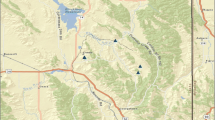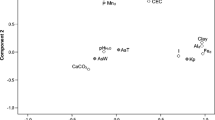Abstract
Historic applications of lead arsenate pesticides and smelting activities have resulted in elevated concentrations of arsenic in Washington State soils. For example, old orchard topsoils in Washington have concentrations reaching upwards of 350 mg As/kg soil with an estimated 187,590 acres of arsenic contamination from pesticide application alone. Iron oxides have been indicated as a key factor in modulating the fate and transport of arsenic in the soil environment. We employed a factorial design to investigate the role of a specific iron oxide, hydrous ferric oxide (HFO), and terrestrial organisms on the mobility, bioavailability, and fate of arsenic and iron in locally collected soils. Earthworms in soils amended with both arsenic and HFO had 47.2 % lower arsenic tissue concentrations compared to those in soils only amended with arsenic. Similarly, arsenic leachate concentrations and plant tissue concentrations were lower when HFO was present, although this was with a reduced magnitude and was not consistently significant. A lack of significance of HFO in three of the linear models for leachate and plant bioavailability, however, indicates that the role of HFO in arsenic mobility, bioavailability, and fate is more complicated than can be explained by the simple addition or not of HFO. For example, our analyses showed that earthworms decreased pH and increased bioavailability for both arsenic and iron as demonstrated by increases in leachate and plant tissue concentrations. The mechanisms for this could include a biotransformation of earthworm-ingested arsenic combined with an earthworm-induced change in pH. We also found that arsenic amendments increased the mobility and bioavailability of iron, evidenced by increased iron concentrations in earthworms, plants, and leachate. A mechanistic explanation for this change in bioavailability is not readily apparent but does support a need for more work on bioavailability when mixtures are present. From these results, it is clear that a combination of biotic and abiotic factors influences metal/metalloid fate and transport in soils, with earthworms being one of the most important factors in our work. Study designs such as the factorial analysis can help to address the role each factor plays while efficiently generating new hypotheses and areas of inquiry; this approach can also bridge knowledge generated through reductionist and holistic approaches to complex environmental problems.






Similar content being viewed by others
References
Abdul Rida AA, Bouché MB (1995) The eradication of an earthworm genus by heavy metals in southern France. Appl Soil Ecol 2(1):45–52
Agbaire PO, Emoyan OO (2012) Bioaccumulation of heavy metals by earthworm (Lumbricus terrestris) and associated soils in domestic dumpsite in Abraka, Delta state, Nigeria. Int J Pl An and Env Sci 2(3):204–209
Al-Abed SR, Jegadeesan G, Purandare J, Allen D (2007) Arsenic release from iron rich mineral processing waste: influence of pH and redox potential. Chemosphere 66(4):775–782
Area-Wide Soil Contamination Task Force (2003) Area-wide soil contamination task force report. Prepared for Washington State Department of Ecology, Olympia, WA. [http://www.ecy.wa.gov/programs/tcp/area_wide/Final-Report/PDF/TF-Report-final.pdf ]. Accessed 12 Apr 2016
ASTM (2004) Annual book of ASTM methods. ASTM E 1197-87 Standard test method for conducting a terrestrial soil-core microcosm test (reapproved 1998). ASTM International, West Conshohocken, PA. 11.05:422–430
Azcue JM, Mudroch A, Rosa F, Hall GEM (1994) Effects of abandoned gold mine tailings on the arsenic concentrations in water and sediments of Jack of Clubs Lake, BC. Environ Technol 15(7):669–678
Berthouex PM, Brown LC (2002) Statistics for environmental engineers, 2nd edn. Lewis publishers, Boca Raton
Bingol D, Tekin N, Alkan M (2010) Brilliant yellow dye adsorption onto sepiolite using a full factorial design. Appl Clay Sci 50(3):315–321
Bose P, Sharma A (2002) Role of iron in controlling speciation and mobilization of arsenic in subsurface environment. Water Res 36(19):4916–4926
Bouyoucos GJ (1962) Hydrometer method improved for making particle size analyses of soils. Agron J 54(5):464–465
Burton ED, Johnston SG, Kocar BD (2014) Arsenic mobility during flooding of contaminated soil: the effect of microbial sulfate reduction. Environ Sci Technol 48(23):13660–13667
Cheng J, Wong MH (2002) Effects of earthworms on Zn fractionation in soils. Biol Fert Soils 36(1):72–78
Comino E, Menegatti S, Fiorucci A, Schwitzguebel JP (2011) Accumulation and translocation capacity of As, Co, Cr and Pb by forage plants. Agrochimica 55(2):105–115
Covey AK, Furbish DJ, Savage KS (2010) Earthworms as agents for arsenic transport and transformation in roxarsone-impacted soil mesocosms: a μXANES and modeling study. Geoderma 156:99–111
de Freitas-Silva L, de Araújo TO, da Silva LC, de Oliveira JA, de Araujo JM (2016) Arsenic accumulation in Brassicaceae seedlings and its effects on growth and plant anatomy. Ecotox Environ Safe 124:1–9
Delistraty D, Yokel J (2014) Ecotoxicological study of arsenic and lead contaminated soils in former orchards at the Hanford site, USA. Environ Toxicol 29(1):10–20
Dixit S, Hering JG (2003) Comparison of arsenic (V) and arsenic (III) sorption onto iron oxide minerals: implications for arsenic mobility. Environ Sci Technol 37(18):4182–4189
Fernández E, Jiménez R, Lallena AM, Aguilar J (2004) Evaluation of the BCR sequential extraction procedure applied for two unpolluted Spanish soils. Environ Pollut 131(3):355–364
Ford RG (2002) Rates of hydrous ferric oxide crystallization and the influence on coprecipitated arsenate. Environ Sci Technol 36(11):2459–2463
Hood E (2006) The apple bites back: claiming old orchards for residential development. Environ Health Persp 114(8):A470
Inglett PW, Reddy KR, Corstanje R (2005) Anaerobic soils. In: Hillel D (ed) Encyclopedia of soils in the environment. Academic Press, London, p 72–78
Janssen HH (1989) Heavy metal analysis in earthworms from an abandoned mining area. Zool Anz 222(5/6):306–321
Karimi N, Ghaderian SM, Raab A, Feldmann J, Meharg AA (2009) An arsenic-accumulating, hypertolerant brassica, Isatis capadocica. New Phytol 184(1):41–47
Korte NE, Fernando Q (1991) A review of arsenic (III) in groundwater. Crit Rev Env Sci Technol 21(1):1–39
Kumar KV, Singh N, Behl HM, Srivastava S (2008) Influence of plant growth promoting bacteria and its mutant on heavy metal toxicity in Brassica juncea grown in fly ash amended soil. Chemosphere 72(4):678–683
Lafferty BJ, Loeppert RH (2005) Methyl arsenic adsorption and desorption behavior on iron oxides. Environ Sci and Technol 39:2120–2127
Langdon CJ, Piearce TG, Meharg AA, Semple KT (2003) Interactions between earthworms and arsenic in the soil environment: a review. Environ Pollut 124(3):361–373
Larios R, Fernández-Martínez R, Rucandio I (2012) Comparison of three sequential extraction procedures for fractionation of arsenic from highly polluted mining sediments. Anal Bioanal Chem 402(9):2909–2921
Lee BT, Kim KW (2013) Toxicokinetics and biotransformation of As (III) and As (V) in Eisenia fetida. Hum Ecol Risk Assess: An International Journal 19(3):792–806
Lee BT, Lee SW, Kim KR, Kim KW (2013) Bioaccumulation and the soil factors affecting the uptake of arsenic in earthworm, Eisenia fetida. Environ Sci Pollut R 20(12):8326–8333
Martell E (2010) Naturally occurring aqueous arsenic and seawater intrusion on Lummi Island, WA. WWU Masters Thesis Collection. http://cedar.wwu.edu/wwuet/83. Accessed 15 Apr 2016
Martinez-López S, Martinez-Sánchez M, Pérez-Sirvent C, Bech J, Martinez MCG, Garciá-Fernandez AJ (2014) Screening of wild plants for use in the pytoremediation of mining-influenced soils containing arsenic in semiarid environments. J Soils Sediments 14:794–809
Masscheleyn PH, Delaune RD, Patrick WH Jr (1991) Effect of redox potential and pH on arsenic speciation and solubility in a contaminated soil. Environ Sci Technol 25(8):1414–1419
Müller K, Daus B, Morgenstern P, Wennrich R (2007) Mobilization of antimony and arsenic in soil and sediment samples–evaluation of different leaching procedures. Water Air Soil Poll 183(1–4):427–436
Nadgórska-Socha A, Ptasiński B, Kita A (2013) Heavy metal bioaccumulation and antioxidative responses in Cardaminopsis arenosa and Plantago lanceolata leaves from metalliferous and non-metalliferous sites: a field study. Ecotoxicology 22(9):1422–1434
Peryea FJ (1998) Historical use of lead arsenate insecticides, resulting soil contamination and implications for soil remediation. 16th World Congress of Soil Science, Montpellier, France 20–26. http://soils.tfrec.wsu.edu/leadhistory.htm. Accessed 15 Apr 2016
Peryea FJ, Creger TL (1994) Vertical distribution of lead and arsenic in soils contaminated with lead arsenate pesticide residues. Water Air Soil Poll 78(3–4):297–306
Pickering IJ, Prince RC, George MJ, Smith RD, George GN, Salt DE (2000) Reduction and coordination of arsenic in Indian mustard. Plant Physiol 122(4):1171–1178
Raab A, Williams PN, Meharg A, Feldmann J (2007) Uptake and translocation of inorganic and methylated arsenic species by plants. Environ Chem 4:197–203
Rahman MA, Rahman MM, Kadohashi K, Maki T, Hasegawa H (2011) Effect of external iron and arsenic species on chelant-enhanced iron bioavailability and arsenic uptake in rice (Oryza sativa L.). Chemosphere 84(4):439–445
Raven KP, Jain A, Loeppert RH (1998) Arsenite and arsenate adsorption on ferrihydrite: kinetics, equilibrium, and adsorption envelopes. Environ Sci Technol 32(3):344–349
San Juan C (1994) Natural background soil metals concentrations in Washington State. Toxic Cleanup Program
Schooley T, Weaver M, Mullins D, Eick M (2008) The history of lead arsenate use in apple production: comparison of its impact in Virginia with other states. J Pestic Safe Ed 10:22–53
Sinha S, Sinam G, Mishra RK, Mallick S (2010) Metal accumulation, growth, antioxidants and oil yield of Brassica juncea L. exposed to different metals. Ecotox Environ Safe 73(6):1352–1361
Sizmur T, Hodson ME (2009) Do earthworms impact metal mobility and availability in soil?—A review. Environ Pollut 157(7):1981–1989
Smedley PL, Kinniburgh DG (2002) A review of the source, behaviour and distribution of arsenic in natural waters. Appl Geochem 17(5):517–568
Tlustoš P, Száková J, Stárková A, Pavlíková D (2005) A comparison of sequential extraction procedures for fractionation of arsenic, cadmium, lead, and zinc in soil. Cent Eur J Chem 3(4):830–851
US EPA (2004) SW-846 test method 9045D: soil and waste pH. https://www.epa.gov/hw-sw846/sw-846-test-method-9045d-soil-and-waste-ph. Accessed 16 May 2016
Vereș DS (2012) A comparative study between loss on ignition and total carbon analysis on mineralogenic sediments. Stud Univ Babes-Bol 47(1):171–182
Washington State DOE (2013) Washington State Legislature Ch. 70.105d RCW. Hazardous waste cleanup–Model Toxics Control Act
Wilkie JA, Hering JG (1996) Adsorption of arsenic onto hydrous ferric oxide: effects of adsorbate/adsorbent ratios and co-occurring solutes. Colloid Surface A 107:97–110
Wolz S, Fenske RA, Simcox NJ, Palcisko G, Kissel JC (2003) Residential arsenic and lead levels in an agricultural community with a history of lead arsenate use. Environ Res 93(3):293–300
Yu X, Cheng J, Wong MH (2005) Earthworm–mycorrhiza interaction on Cd uptake and growth of ryegrass. Soil Biol Biochem 37(2):195–201
Zhao Z, Jia Y, Xu L, Zhao S (2011) Adsorption and heterogeneous oxidation of As (III) on ferrihydrite. Water Res 45(19):6496–6504
Acknowledgments
The authors would like to thank Macon Abernathy (WWU), Edward Bain, (WWU), and Kyle Mikkelsen (AMSEC - WWU) for their technical support of this project. Funding was provided by the Washington State Department of Ecology in support of student scientific research under Interagency Agreement C1600069.
Author information
Authors and Affiliations
Corresponding author
Additional information
Responsible editor: Zhihong Xu
Rights and permissions
About this article
Cite this article
Maki, B.C., Hodges, K.R., Ford, S.C. et al. The influence of hydrous ferric oxide, earthworms, and a hypertolerant plant on arsenic and iron bioavailability, fate, and transport in soils. Environ Sci Pollut Res 24, 27710–27723 (2017). https://doi.org/10.1007/s11356-016-7852-1
Received:
Accepted:
Published:
Issue Date:
DOI: https://doi.org/10.1007/s11356-016-7852-1




